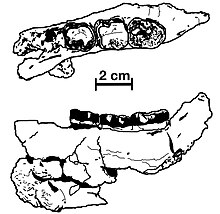Nakalipithecus
| Nakalipithecus | |
|---|---|

| |
| Top and side views of the Nakalipithecus molars
| |
| Scientific classification | |
| Domain: | Eukaryota |
| Kingdom: | Animalia |
| Phylum: | Chordata |
| Class: | Mammalia |
| Order: | Primates |
| Suborder: | Haplorhini |
| Infraorder: | Simiiformes |
| Superfamily: | Hominoidea |
| Family: | Hominidae |
| Genus: | †Nakalipithecus Kunimatsu et al., 2007 |
| Species: | †N. nakayamai
|
| Binomial name | |
| †Nakalipithecus nakayamai Kunimatsu et al., 2007
| |
Nakalipithecus nakayamai, sometimes referred to as the Nakali ape,
Taxonomy
| Hominidae | |||||||||||||||||||||||||||
| |||||||||||||||||||||||||||
| Two hypotheses on Nakalipithecus taxonomy[2] |
million years ago ) |
Nakalipithecus was first described from a right jawbone, the
It is debated if great
Nakalipithecus and the 9 million year old Greek
Nakalipithecus has also been proposed to have been the ancestor to the 8 million year old Chororapithecus, which possibly represents an early member of the gorilla line; if both of these are correct, then Nakalipithecus could potentially represent an early gorilla.[2]
Anatomy
Nakalipithecus has an overall large size, with teeth similar in size to those of female gorillas and orangutans. The specimen is thus presumed female. The Samburupithecus specimen was also about the same size. Unlike other apes, the canines are short, and as long as they are wide—about 10.7 mm × 10.5 mm (0.42 in × 0.41 in) in height and width respectively. For comparison, the left first incisor is 10.8 mm × 8.6 mm (0.43 in × 0.34 in). The premolars are elongated, and the
Palaeobiology
During the Late Miocene, East Africa, the
Nakali has also yielded a
See also
References
- ^ Kiarie, Maina. "Nakalipithecus". Enzi Museum. Retrieved 8 August 2023.
- ^ S2CID 205247254.
- ^ PMID 18024593.
- ISSN 0286-9667.
- hdl:2115/71435.
- ^ .
- S2CID 135074081.
- ^ .
- . 147.
- PMID 20949609.
- .
External links
- Human Timeline (Interactive) – Smithsonian, National Museum of Natural History (August 2016).
- "Mama, Is That You? Possible Ape Ancestor Found". Discovery News. Version of 2007-NOV-12. Retrieved 2007-NOV-13. Contains photo of fossil.
